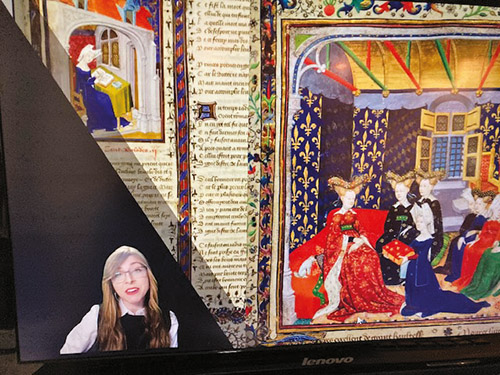
Last Sunday evening, in commemoration of the eighth yahrtzeit of Sara Lamm Dratch, z”l, the Jewish Center of Teaneck presented the fourth annual Sara Lamm Dratch Memorial Lecture, “Esther Ever After, a Life and Legacy in Full Color,” to participants via Zoom.
The lecture series was founded by Tamar and Yigal Gross, Dratch’s niece and nephew, “to perpetuate Sara’s memory by creating a forum for emerging female scholars to share their wisdom with the community at large.” Sponsors included members of the Warburg, Gross, Dratch and Lamm families.
Introductory remarks were delivered by Rabbi Daniel Fridman of the Jewish Center, who also coordinated and hosted the lecture. He spoke briefly of the late Rabbi Dr. Norman and Mindella Lamm, z”l, noting the exemplary dignity of their “silence” in response to the swift and tragic loss of their beloved daughter, Sara. Sara Dratch, he said, “lived and left a legacy of simcha, regardless of whether the circumstances supported it, consciously generating joy.”
Keynote speaker for the evening was Shaina Trapedo, Ph.D., lecturer in English at Stern College and visiting scholar at the Straus Center for Torah and Western Thought at Yeshiva
University. Trapedo is currently working on the book “From Scripture to Script: The Hebrew Bible on the Early Modern Stage,” and she continues to explore the connections between literacy, cultural identity and social engagement in her teaching and scholarship.
Trapedo opened her lecture with the concept that the messages of literature and the arts depend on the time in history when they are written. Referring to this idea as “cultural tofu,”
she asserted that a story or a stage performance will “take on the flavor” of the era in which it is written. With this notion as a backdrop, Trapedo went on to explain that “stories exert power and shape life, goals and behavior.”
Through the lecture, she brought forward examples in literature and stage productions primarily from the Middle Ages and advanced into the Renaissance period, directed at the Purim story of Esther. Supported by beautiful and brightly colored illustrations of paintings and stage production art from the era, Trapedo transformed into a cultural tour guide, taking the listeners into the literature and amphitheaters of the 15th, 16th and 17th centuries. The tour wove a tapestry of the themes of Esther’s stature as a woman, queen, politician and leader.
Trapedo showed actual texts and content from archived books, plays and artwork. As she exhibited these artifacts of literary history and performance, she illustrated via word and art—including a Rembrandt circa 1635—how some sources remain true to the text of the Megilla. Others clearly depart from the authentic Megilla as we know it, taking literary license and creating their own twists on the Purim story and Esther’s role in it.
Trapedo explained that because Esther is held in such high esteem by even non-Jewish and noble societies, the accuracy of the story can take on less importance compared to the admirable and important qualities of Esther herself. “Every act of representation is an act of interpretation,” Trapedo said, “so that the commentary reveals values and beliefs more than the text they present.” The importance shifts to the role model, ethics and values that Esther presents, and away from the textual accuracy in the medieval European stage or storybook.
Here Trapedo cinched the knot, having identified the abundance of evidence seen in Middle Ages arts and literature. Through her behavior with the king and the risks it involved, Esther burst the bubble of denial, proving that “women aren’t inherently weak; women possess political intelligence and are also [keenly] aware of the rules of engagement.”
Concluding, Trapedo said that we have also seen the paragon of Jewish female beauty in the 20th century with the advent of the Queen Esther Contest, held at Madison Square Garden in 1933. “Women have countenance, character, and [don] a royal robe, in preparation to fulfill a purpose of favor to the king,” she said.
By Ellie Wolf











